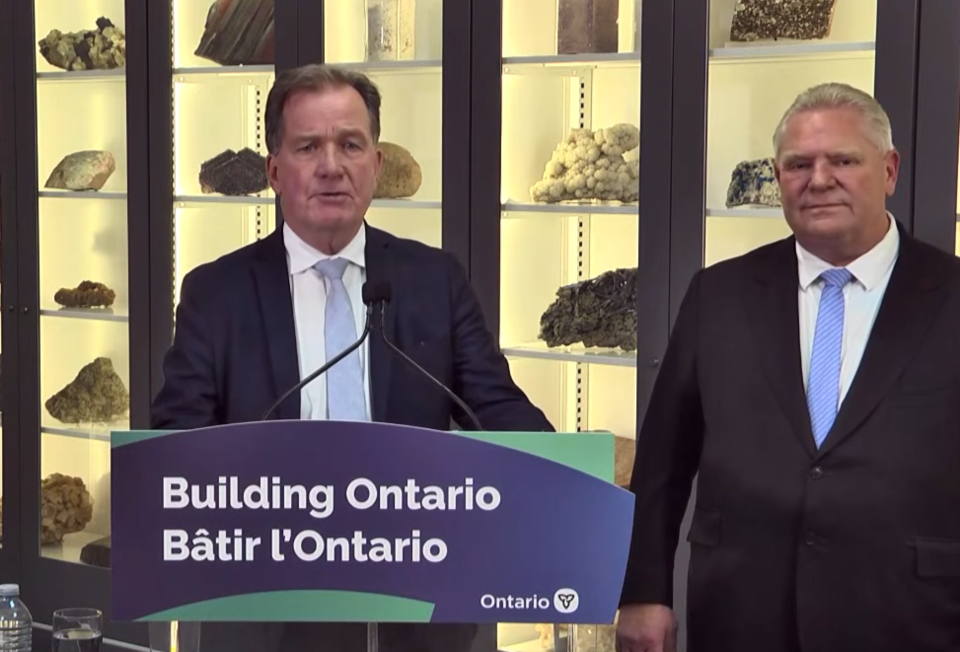Expect a major announcement on the north-south road to the Ring of Fire during the PDAC mining convention in March.
That was the word from Premier Doug Ford and Mines Minister George Pirie during a Jan. 13 press conference in Toronto to promote Fortress Am-Can, touted as a new strategic alliance between Canada and the U.S. that involves a plan to fast-track critical minerals production.
Critical minerals and the untapped potential of the Ring of Fire received frequent mention by Ford, Pirie and Northern Development and Indigenous Minister Greg Rickford.
They touched on cutting red tape to expedite approvals of new mines while working closely with First Nations and U.S. legislators to get minerals mined, processed and shipped to the factory floor.
Pirie said Ontario’s “ready to mine, ready to manufacture, ready to trade and ready to power the economies of the future in partnership with our American allies.”
Critical minerals and energy production are key bargaining chips for Ontario and Canada in negotiating with the U.S. to avoid the threat of costly tariffs from the incoming Trump administration against Canadian goods shipped across the border.
Ontario wants to be a global leader in critical minerals in marketing the province as a responsible and reliable miner of nickel, copper, lithium and other metals for the U.S. battery, electrical vehicle, medical, military and advanced technology sectors.
The undeveloped Ring of Fire mineral belt in Ontario’s Far North is one area where these minerals can be sourced.
Pirie confirmed engineering survey teams are operating in the area of Greenstone-Aroland First Nation as part of the environmental assessment for the road, which involves a soil sampling program prior to any construction.
Securing Aroland First Nation as a development partner is vital since that community is located at the southern end of a proposed north-south road and transhipment ship where mined materials will be railed away for processing.
Queen’s Park has been in talks with Aroland Chief Sonny Gagnon to start the first 80 kilometres of that road.
Ford, who made three appearances in the Greenstone-Aroland area of northwestern Ontarion in 2024, said the province has a good relationship with Gagnon, who’s “just gung-ho, ready to go”on road development.
Reaching a road agreement is being finalized and should be announced shortly, said Ford.
“We just have to cross the ‘t’s’ and dot the ‘i’s.’”
Pirie said to expect an official announcement on that agreement during annual Prospectors and Developers Association Conference in March.
Pirie, a former mining executive who was involved in road construction of the Musselwhite mine road in the late 1990s, said 85 per cent of the proposed Ring of Fire will be built atop identified glacial eskers on the route north.
Based on his interactions with area chiefs, Ford claims area First Nation leaders are positive about development that will bring jobs, prosperity, investment in vital infrastructure and deliver a better standard of living
“They want it, we’re going to support them.”
Rickford said Ontario is building consensus with a majority of First Nations in constructing legacy infrastructure for the communities and to support resource development.
Most chiefs in the region are “generally satisfied,” he said, but there remain points of contention expressed by others. He viewed the latter group as an opportunity to understand and prioritize what they would like to see happen.
A government showing a tangible commitment to develop the Ring of Fire, long after the first nickel and chromite discoveries in 2007-08, comes at a crucial time.
In taking questions from reporters, Ford struck a conciliatory wait-and-see tone on the threat of tariffs, but warned he wouldn’t hesitate to support retaliatory measures against the U.S. should cross-border relations break out into a trade war.
Ford pointed out that Ontario is the first export destination for 17 American states and second-ranked trading partner for 11 other states. On the critical minerals side, he said Canada is the primary supplier of nickel to the U.S. at 46 per cent.
Ford said he’s been speaking with elected U.S. officials at the federal and state levels, who rely on Canada as a cross-border trading partner, to “get the message out.”
“Let’s try to avoid these tariffs. It’s going to hurt them and it’s going to hurt us, don’t get me wrong, but it’s going to hurt them just as much, and we’ll make sure it hurts them.”
Ford’s Fortress Am-Can is a bold new strategy that involves a critical minerals security alliance to build a minerals supply chains that involves bringing new mines in production and expanding processing capacity.
Part of the new measures associated with Fortress Am-Can involves working with Ottawa to speed up regulatory timelines for critical mineral projects with a special approvals approach of one-project, one-permit.
Areas where critical minerals are found — like the Ring of Fire — would be designated as regions of strategic importance to North American security. Ontario also wants to promote First Nation equity and participation in this project in respecting governments duty to consult.
Ford proposes a new cross-border working group of federal legislators and industry leaders to promote long-term sustainability of critical minerals development projects and crack down on foreign investment shortselling tactics that undermine the exploration sector.
